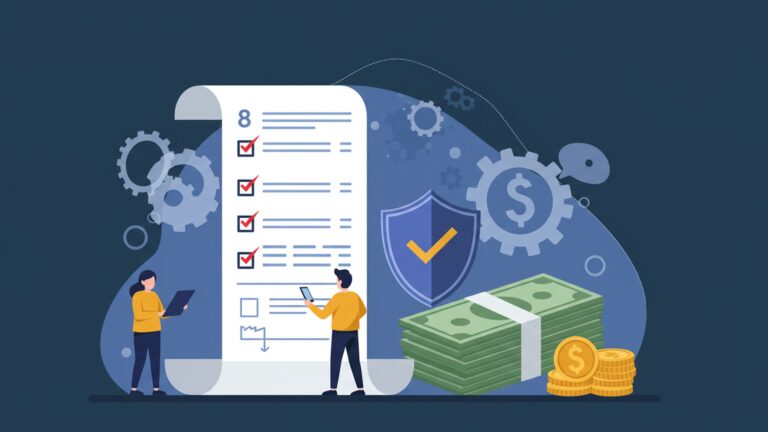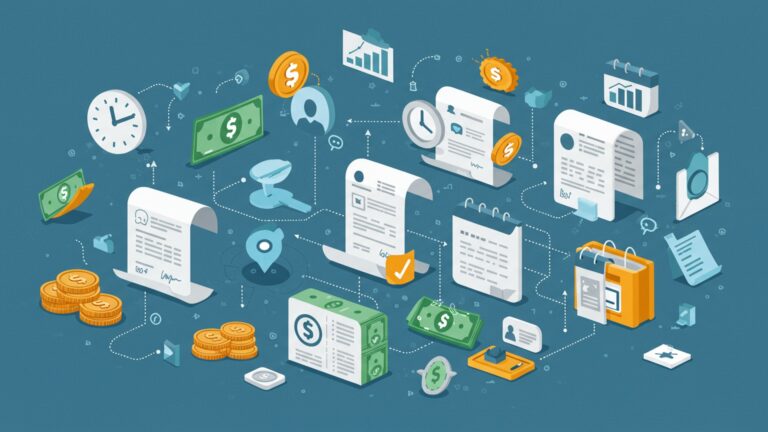Discover 7 Simple Ways to Prevent Billing Errors and Save Your Business Money
In an era where digital transactions dominate and accounting software promises flawless execution, businesses still grapple with significant financial leakage due to preventable billing errors. A single misplaced decimal, an unapplied discount, or an overlooked service code can cascade into revenue discrepancies, erode customer trust. trigger time-consuming reconciliation efforts, impacting profitability. Recent analyses show that even sophisticated automated systems are vulnerable to human input errors or integration glitches, making proactive strategies to prevent billing errors more critical than ever for maintaining a healthy bottom line and operational efficiency.

1. Implement Robust Digital Invoicing Systems
One of the most effective strategies to prevent billing errors is to move away from manual invoicing processes. Digital invoicing systems, often integrated with accounting software, significantly reduce the human error associated with data entry, calculation. delivery.
Think about a small business that relies on spreadsheets and manual data entry. A typo in a quantity, an incorrect unit price, or a miscalculation of sales tax can lead to an inaccurate invoice. This not only costs money but can also damage client relationships. Digital systems automate these calculations and can cross-reference data from inventory, time tracking. CRM (Customer Relationship Management) systems.
Key features of robust digital invoicing systems include:
- Automated calculation of totals, taxes. discounts.
- Integration with payment gateways for streamlined collection.
- Ability to schedule recurring invoices.
- Audit trails for every invoice generated and sent.
- Customizable templates to ensure professional branding and consistent data.
By leveraging these systems, businesses can drastically prevent billing errors, ensuring accuracy and efficiency from the start.
2. Standardize Your Pricing and Contract Management
Inconsistency in pricing and contract terms is a fertile ground for billing mistakes. When different sales representatives or project managers quote varying prices for the same service or product, or when contract terms are not uniformly applied, errors are inevitable. To prevent billing errors, it’s crucial to establish clear, standardized pricing models and a centralized contract management system.
This involves:
- Creating a Master Price List
- Standardized Contract Templates
- Version Control
A single, accessible document or database detailing all product/service prices, discounts. special rates. This ensures everyone is working from the same insights.
Develop pre-approved contract templates for different services or client tiers. These templates should clearly outline payment terms, deliverables. pricing structures.
For custom contracts, implement a system that tracks changes and ensures the final, approved version is the one used for billing.
Consider a marketing agency that offers various packages. If each account manager customizes packages and pricing on the fly without a central reference, billing can become a nightmare. Standardizing these elements helps to prevent billing errors by creating a predictable and verifiable framework for all transactions.
3. Implement a Multi-Stage Review and Approval Process
Even with automation, human oversight remains vital. A multi-stage review and approval process acts as a critical safety net to catch errors before an invoice reaches the client. This involves more than one person checking the invoice for accuracy.
A typical process might look like this:
- Preparer
- First Reviewer
- Final Approver
The person responsible for compiling the initial invoice (e. g. , project manager, sales associate).
An independent party (e. g. , a team lead or a dedicated billing clerk) checks the invoice against the contract, time logs. expense reports. They look for discrepancies in quantity, price, dates. client insights.
A senior manager or financial controller gives the final sign-off, ensuring compliance with company policies and client agreements.
A real-world example: A consulting firm found frequent errors when individual consultants directly sent invoices. By implementing a process where an administrative assistant first reviewed the consultant’s time sheets against project scope. then a finance manager approved the final invoice, they significantly reduced billing discrepancies. This layered approach is incredibly effective to prevent billing errors from impacting your bottom line and reputation.
4. Reconcile Accounts and Statements Regularly
Consistent reconciliation is a cornerstone of accurate financial management and a powerful tool to prevent billing errors. This means comparing your internal records (e. g. , general ledger, accounts receivable) with external statements (e. g. , bank statements, credit card statements, client payment records) on a regular basis – ideally monthly. sometimes weekly for high-volume businesses.
What to look for during reconciliation:
- Missing Payments
- Unapplied Payments
- Duplicate Payments
- Incorrect Amounts
- Unauthorized Charges
Ensure all payments received are correctly recorded against the corresponding invoices.
Sometimes payments are received but not linked to a specific invoice, leading to perceived outstanding balances.
Clients might accidentally pay twice, requiring a refund and correction.
Discrepancies between what was billed and what was paid.
Identifying any charges on your bank statements that don’t match your records.
By proactively reconciling, you can identify and rectify errors promptly. For instance, if your accounts receivable ledger shows an outstanding invoice. the client’s payment portal confirms payment, reconciliation highlights this discrepancy, allowing you to investigate and correct your records. This vigilance is key to prevent billing errors from snowballing into larger financial issues.
5. Invest in Employee Training and Clear Communication
People are at the heart of any process. proper training is indispensable for preventing billing errors. Your team needs to interpret not just ‘how’ to perform billing tasks. also ‘why’ certain procedures are in place and the impact of errors.
Training should cover:
- Software Proficiency
- Company Policies
- Common Error Types
- Escalation Procedures
Ensuring all users are experts in the invoicing and accounting software.
Clear guidelines on pricing, discounts, payment terms. credit limits.
Educating staff on frequently occurring mistakes and how to avoid them.
What to do when an error is identified or a client disputes an invoice.
Beyond initial training, ongoing education and open communication channels are vital. Regular check-ins, feedback sessions. updates on policy changes keep everyone on the same page. A culture where employees feel comfortable reporting potential issues without fear of reprisal encourages early detection and correction, making it far easier to prevent billing errors before they become costly problems.
6. Leverage Automation for Time Tracking and Expense Management
For service-based businesses or project-oriented work, accurate time tracking and expense management are foundational to correct billing. Manual logs, hastily scribbled notes, or forgotten expenses are prime sources of billing inaccuracies. Automating these processes is a game-changer.
Consider using dedicated software for:
- Time Tracking
- Expense Management
Tools that allow employees to log hours against specific projects or tasks in real-time. Many integrate with project management software and even payroll systems.
Platforms where employees can upload receipts, categorize expenses. submit for approval digitally. This eliminates lost receipts and simplifies reimbursement.
For example, a law firm uses an integrated system where attorneys log billable hours directly into a project management tool. This data then automatically populates client invoices, drastically reducing manual entry errors. Similarly, a construction company uses an app for field workers to photograph receipts for materials purchased on-site, ensuring all costs are captured accurately. These technologies not only save time but are crucial to prevent billing errors that stem from incomplete or inaccurate source data.
Here’s a simplified example of how a time tracking system might integrate:
// Pseudocode for time entry and billing integration
function logTime(employeeId, projectId, hours, description) { // Save time entry to database db. saveTimeEntry({ employeeId, projectId, hours, description, date: new Date() });
} function generateInvoice(projectId, clientName, rate) { let totalHours = db. getTimeEntriesForProject(projectId). sum('hours'); let totalExpenses = db. getExpensesForProject(projectId). sum('amount'); let subtotal = totalHours rate + totalExpenses; let tax = subtotal 0. 05; // Example tax rate let grandTotal = subtotal + tax; // Create and send invoice sendInvoiceToClient(clientName, { projectId, totalHours, totalExpenses, rate, grandTotal });
}
7. Cultivate Clear and Proactive Client Communication
Many billing errors escalate because of a lack of clear communication with clients. Setting expectations upfront and maintaining open dialogue throughout the service period can prevent misunderstandings that lead to invoice disputes. This isn’t just about reactive problem-solving; it’s about proactive engagement.
Strategies for effective client communication include:
- Detailed Proposals and Contracts
- Regular Updates
- Clarification on Changes
- Invoice Review Calls
Ensure proposals clearly outline scope, deliverables, pricing. payment terms. These should be thoroughly reviewed and agreed upon by the client before work begins.
For longer projects, provide periodic updates on progress and, if applicable, a summary of incurred costs or hours against the budget. This avoids “sticker shock” at the end of the project.
Any changes in scope, additional work, or unforeseen expenses should be communicated and approved by the client in writing before being billed.
For large or complex invoices, consider scheduling a brief call with the client to walk them through the charges.
A web development agency often sends a “project burn rate” report weekly, showing hours used versus remaining budget. This transparency helps clients comprehend how their money is being spent and allows for adjustments before the final invoice is generated. When clients feel informed and involved, they are less likely to dispute invoices, making it easier to prevent billing errors from souring relationships and delaying payments.
Conclusion
Preventing billing errors isn’t merely about correcting mistakes; it’s a proactive strategy for safeguarding your business’s financial integrity. By embracing the simple ways outlined, from meticulous data entry to leveraging intelligent POS systems for automated checks, you effectively plug profit leaks. I’ve personally seen businesses, particularly small retailers navigating the nuances of GST, significantly reduce their annual losses by implementing real-time reconciliation and regular audits. This vigilance, coupled with user-friendly software that flags anomalies instantly, transforms potential headaches into seamless operations. Embrace technology as your ally; modern billing solutions are designed to minimize human error, offering features like automatic tax calculations and inventory synchronization, a critical trend in today’s fast-paced market. Don’t underestimate the power of a well-trained team either, as their attention to detail forms the final line of defense. By making these practices a cornerstone of your operations, you’re not just preventing errors; you’re building a more resilient, profitable. future-proof business. For a deeper dive into transforming your operational efficiency, consider exploring how POS Billing Software Transforms Your Business Operations.
More Articles
Discover How POS Billing Software Transforms Your Business Operations
Master Your GST Invoicing with 7 Essential Tips and Best Practices
7 Essential GST Invoicing Tips for Small Business Success
How to Choose the Best Android POS Software for Your Business
7 Smart Ways Restaurant Billing Software India Boosts Your Profits
FAQs
What are billing errors. why are they such a big deal for my business?
Billing errors are mistakes in your invoices or payments, like wrong prices, incorrect quantities, or double charges. They’re a big deal because they can directly cost your business money through lost revenue or overpayments, damage customer trust. waste valuable time fixing avoidable problems.
I’m a small business owner; how can I realistically start preventing these errors without a huge investment?
Start with the basics! Focus on consistent data entry, double-checking invoices before sending them out or making payments. maintaining clear, organized records. Even small, consistent steps can make a significant difference without needing expensive software right away.
What are some of those ‘simple ways’ you mentioned to avoid these financial slip-ups?
Simple ways include having crystal-clear pricing structures, using standardized templates for all invoices, cross-referencing purchase orders with incoming invoices. implementing a quick, two-person review system for critical billing documents before they go out or get paid.
Can technology really help much with preventing billing errors, or is it mostly about manual checks?
Technology can be a huge help! Accounting software can automate calculations, track payments. flag discrepancies, significantly reducing the chance of human error. Even simple spreadsheet formulas can ensure accuracy in smaller operations, so you don’t have to rely solely on manual checks.
My team sometimes makes these kinds of mistakes. How can I get them more engaged and accurate?
Training is absolutely key. Educate your team on the importance of accuracy, provide clear, easy-to-follow guidelines for all billing processes. show them the real impact errors have on the business. Encourage a culture where it’s okay to ask questions and double-check, fostering a proactive approach to accuracy.
Besides just saving money, what other benefits can my business expect from fewer billing errors?
Beyond the direct financial savings, you’ll see happier customers who receive accurate invoices, improved cash flow from faster and correct payments. less time wasted on dispute resolution. This frees up valuable resources for more productive tasks and enhances your business’s professional image.
How often should I review my billing processes to ensure everything is running smoothly and errors stay minimal?
It’s a really good idea to conduct regular reviews, perhaps quarterly or semi-annually, depending on your business volume and complexity. This helps catch any new issues, adapt to changes in your business operations. reinforce good practices. Don’t wait for problems to pop up before taking a look!






